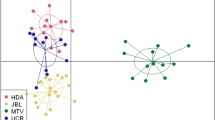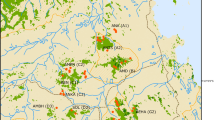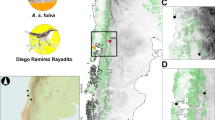Agricultural intensification is blamed for the plummeting populations of these birds.
Abstract
House-sparrow populations have declined sharply in Western Europe in recent decades1,2, but the reasons for this decline have yet to be identified, despite intense public interest in the matter. Here we use a combination of field experimentation, genetic analysis and demographic data to show that a reduction in winter food supply caused by agricultural intensification is probably the principal explanation for the widespread local extinctions of rural house-sparrow populations in southern England. We show that farmland populations exhibit fine-level genetic structuring and that some populations are unable to sustain themselves (sinks), whereas others act as sources.
This is a preview of subscription content, access via your institution
Access options
Subscribe to this journal
Receive 51 print issues and online access
$199.00 per year
only $3.90 per issue
Buy this article
- Purchase on Springer Link
- Instant access to full article PDF
Prices may be subject to local taxes which are calculated during checkout

Similar content being viewed by others
References
Krebs, J. R., Wilson, J. D., Bradbury, R. B. & Siriwardena, G. M. Nature 400, 611–612 (1999).
Gregory, R. D. et al. The State of the UK's Birds 2000 (RSPB, BTO and WWT, Sandy, UK, 2001).
Summers-Smith, J. D. The Sparrows (Poyser, Calton, 1988).
Cornuet, J. M. & Luikart, G. Genetics 144, 2001–2014 (1996).
Crochet, P. A. Mol. Ecol. 9, 1463–1469 (2000).
Wernham, C. V. et al. The Migration Atlas: Movements of the Birds of Britain and Ireland (Poyser, London, in the press).
Chamberlain, D. E., Fuller, R. J., Bunce, R. G. H., Duckworth, J. C. & Shrubb, M. J. Appl. Ecol. 37, 771–788 (2000).
Robinson, R. A. & Sutherland, W. J. J. Appl. Ecol. 39, 157–176 (2002).
Hanski, I. Nature 396, 41–49 (1998).
Author information
Authors and Affiliations
Corresponding author
Ethics declarations
Competing interests
The authors declare no competing financial interests.
Rights and permissions
About this article
Cite this article
Hole, D., Whittingham, M., Bradbury, R. et al. Widespread local house-sparrow extinctions. Nature 418, 931–932 (2002). https://doi.org/10.1038/418931a
Issue Date:
DOI: https://doi.org/10.1038/418931a
This article is cited by
-
Comments on the paper “correlation does not imply causation: decline of House Sparrow overshadowed by electromagnetic radiation” by Nath et al.
Urban Ecosystems (2024)
-
Physiological status of House Sparrows (Passer domesticus) along an ozone pollution gradient
Ecotoxicology (2023)
-
Vineyards, but not cities, are associated with lower presence of a generalist bird, the Common Blackbird (Turdus merula), in Western France
Avian Research (2021)
-
Species-specific breeding habitat association of declining farmland birds within urban environments: conservation implications
Urban Ecosystems (2021)
-
Phenotypic divergence despite low genetic differentiation in house sparrow populations
Scientific Reports (2018)
Comments
By submitting a comment you agree to abide by our Terms and Community Guidelines. If you find something abusive or that does not comply with our terms or guidelines please flag it as inappropriate.



